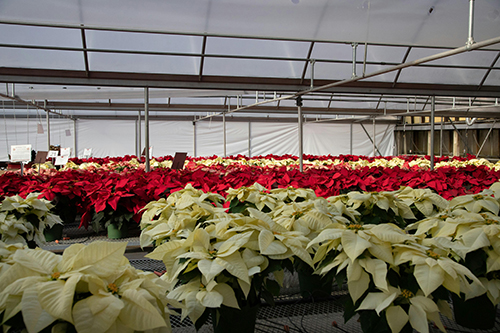Nick Flax is following up last week’s Grower Tip on Rhizoctonia with another poinsettia tip — this time the challenge is fungus gnats.
PROBLEM: When a beautiful poinsettia crop is ready to ship or move to retail, the last thing anyone wants to see is a cloud of fungus gnats (Bradysia sp.) billowing out of the pot. Adult gnats flying around are unsightly, but larvae can damage the roots or the crown of your poinsettias and open the door for pathogens like Pythium.

Photo by Mark Stebnicki
NICK’S TIP: Get those fungus gnats cleaned up NOW so your crop is squeaky clean as it goes out the door to ensure maximum crop longevity and customer satisfaction.
Lead With Moisture Management
Fungus gnats need high soil moisture levels to thrive. As such, the first-line response to rein in fungus gnat pressure is fine-tune your moisture management. However, it can be tricky to accomplish this in a maturing poinsettia crop. If uncooperative weather has necessitated frequent irrigations or your grower team hasn’t reduced irrigation frequency appropriately since the unseasonal warm fall temps finally went away:
• Aim for a slightly drier “wet target.” On the 1 to 5 scale (1 = air dry; 5 = saturated), ensure that growing media never reaches a level 5. Aim for a moisture level 4 or slightly drier (between level 4 and 3) when you irrigate/fertigate and resist the urge to “water for the weekend” on Fridays.
• Reduce spot-watering. While it may seem counterintuitive, frequent spot-watering in a mature poinsettia crop can result in greater unevenness in soil moisture levels across the group. Continue to water the outer row or two of plants in a block to counteract edge effect but resist the urge to give plants in the center of the group an extra splash.
Be careful not to run media too dry and ensure that plants do not dry down to moisture level 1. Too-dry growing media can disrupt calcium uptake and result in calcium deficiency symptoms in your youngest bracts, or stress plants and negatively affect development of cyathia.
Lean Into Your Insecticide Toolbox
Good moisture management can naturally suppress fungus gnats over a longer period, but rarely does the job on its own in the span or a few weeks. To get your plants cleaned up and (mostly) fungus gnat-free before ship/sale, you will have to break out some insecticides.
While flying adults are the more noticeable nuisance, target larvae in the soil as your first step in the campaign against fungus gnats. These pests complete a life cycle in three or four weeks, so larvae in the soil now will become flying adults shortly before your plants ship or go to retail.
While there really isn’t a “quick kill” option for fungus gnat larvae, get a jump on them with at least two different insecticides and/or nematodes from now until ship or sale.
Start the substrate drench rotation with an insect growth regulator (IGR). This class of chemicals plays a critical role in fungus gnat management in floriculture crops, but extra caution is required when it comes to IGRs and poinsettias.
• At this point in the crop cycle, cyromazine (ex. Citation) is one of the few safe IGRs to use on poinsettias.
• Azadirachtin (ex. Azatin, AzaGuard) is another good option to include in the rotation.
• Pyriproxyfen (ex. Distance) is only safe to apply to poinsettias before bract development).
• Diflubenzuron (ex. Adept) should never be applied to poinsettias.
• Gnatrol (Bacillus thuringiensis subsp. israelensis) is another good option to include, and larvae respond to it fairly quickly. Multiple consecutive applications are generally needed to curb a substantial outbreak.
Nematodes (Steinernema fletiae) are another excellent tool to deploy in this situation. These work very well, but you must make repeat applications to get maximum efficacy. I generally recommend at least two applications no more than one week apart the first time you apply them, and then repeat every (approximately) two weeks, as long as fungus gnat pressure stays low. Increase application frequency to weekly if populations jump again.
Be sure to remove all screens and filters from your injector setup, or you’ll basically shred the nematodes before they even make it into the pot. Get a good amount of nematode solution into each pot and make sure soil moisture is moderate (about level 3 on the 1 to 5 scale) before you apply the drench. Nematodes need soil moisture to move around, so it’s critical to ensure they aren’t diving into a bone-dry soil column.
Timing these applications can be tricky, especially if wet-to-dry cycles are infrequent. While I have personally tank-mixed nematodes and fertilizer with great success in the past, be sure to follow your suppliers’ recommendations on applications procedures to ensure maximum efficacy.
While you’re taking care of the larvae, knock down adults to help further break the life cycle. However, be mindful that there are limited options with respect to effective chemistries to combat adult fungus gnats.
• Pyrethroids (ex. bifenthrin, cyfluthrin) are one of the more effective tools to kill fungus gnat adults quickly.
• Decathalon (cyfluthrin) is a wettable powder formulation, so it will likely be safer for bracts than other SC or EC formulations. Keep in mind, since it’s a wettable powder, there’s a chance that some residue may remain on foliage after application.
• Attain TR is another nice option for smaller greenhouse spaces. While many self-contained applicator cans are aerosols and come with potential phyto risks, I’ve worked with lots of growers who use this product in poinsettias showing color without any issues.
• Note: While oil-based products may work to knock down fungus gnat adults, many mineral oil-based products may increase the chances of phyto on tender bracts.